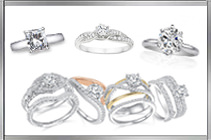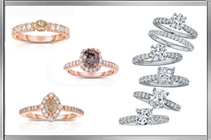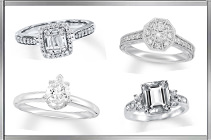The Rules of Engagement
 The Knot Jewelry & Engagement Study of 2017 reveals several key trends for jewelers to keep on their radar. Most notable is that engagement ring spend is at an all-time high.
The Knot Jewelry & Engagement Study of 2017 reveals several key trends for jewelers to keep on their radar. Most notable is that engagement ring spend is at an all-time high.
Among respondents polled, the survey finds they’re living together for longer, slightly older (average bride 29, groom 31), and making more money. They’re buying engagement rings at a higher price point than in years past—spending an average $6,351 on an engagement ring, compared to $5,095 in 2011.
Price does not factor into the top three things couples think about when choosing an engagement ring. Stone cut, setting, and quality are among the highest on the, finds The Knot. Grooms cite price the fourth most important consideration; brides rank it sixth.
The survey also reveals that the bride is more involved in engagement ring shopping, up 5% since 2011, with 70% of women having some input in the final decision—from one in three shopping together to 38% that hint what they want.
The demand for halo styles continues despite jewelers getting tired of it. But many expect the tide to start turning. Russ Whitehouse, director of operations for the Stuttgart, Arkansas manufacturer Wilkerson and the bridal brand John Bagley, sees the next generation of brides moving away from the halo that their mothers have.
Some vendors are seeing a shift in demand for other styles that favor cleaner, simpler looks. “We’re getting more requests for tailored styles with bigger center stones,” says Sadhna Venkat for MWI Eloquence, New York. “Simple tops are popular with diamonds that go down the shank and under the gallery.”
The overall design trend for minimalism is inspiring a comeback of the solitaire, says Rebecca Foerster, executive vice president of strategic planning and marketing, Leo Schachter Diamonds, New York. Popular centers are .50 to 1 carat, but she sees a trend for larger sizes up to 2 carats.The Knot finds the average carat size for center stone to be 1.2 carats, 1.8 total carats for the ring. At the same time, the broader trend for nostalgia continues and many brides are choosing vintage styles. Foerster sees this expressed in interesting heads and details like milgrain around the ring.
The biggest caveat when it comes to engagement rings is the ability to customize them. The Knot survey acknowledges that personalization has made its way into every aspect of the wedding. The ability to customize a ring, whether from scratch in new custom design or changing elements in an existing design, is crucial to closing wedding ring sales, says Neil Shah, Shah Luxury, New York. The Knot cites 45% of engagement rings are a custom design.
“I have not seen the trend for customization as strong as it is today,” concurs Whitehouse. “Jewelers don’t say anymore that their customers buy rings right out of the case. They have to be able to alter styles within certain boundaries or they are stuck in the mud. We offer the ability to customize styles in different metals and combinations, and to accommodate various center stone sizes.”
Fancy Shapes
 Round is still the top choice at 52%, finds The Knot, but oval rings are on the rise. A blip on the radar at 1% of engagement ring purchases in 2011, 7% of couples in 2017 chose an oval cut. Pear, marquise, and cushion are also trending, while princess cuts declined 16% since 2011.
Round is still the top choice at 52%, finds The Knot, but oval rings are on the rise. A blip on the radar at 1% of engagement ring purchases in 2011, 7% of couples in 2017 chose an oval cut. Pear, marquise, and cushion are also trending, while princess cuts declined 16% since 2011.
“Using fancy shapes is a great way of taking a simple silhouette and making it unique,” says Foerster. Venkat cites more demand for three stone rings in fancy shapes, especially since Prince Harry proposed to Meghan Markle with one. She says baguette, trapezoid and pear shapes are popular side stones.
Splash of Color
While white gold remains the preferred wedding ring metal, according to The Knot, two-tone styles are particularly hot, says Venkat. Whitehouse cites an increase in yellow gold sales and sees the popularity of rose gold as regional.
The Knot found morganite a top choice set in rose gold but ranks sapphire the No. 1 non-diamond gemstone engagement ring center—with white diamond still a bride’s favorite. Venkat also cites brown and champagne diamonds coveted as a center with accent stones.
At least 50% of engagement rings are sold without the matching band, says Whitehouse. Stacking continues to be a significant trend, with eternity bands a bestseller, adds Venkat. She says the stacking movement is fueling band sales as consumers are mixing metals, gems, and styles of rings.
Foerster says the trend for solitaires bodes well for stacking bands that can constantly change the look. Brides magazine calls out “V” and wave-shaped stackable bands popular, as well as the trend for a “blinged out band” as an engagement ring. Favorite styles alternate tapered baguettes and trillions.

